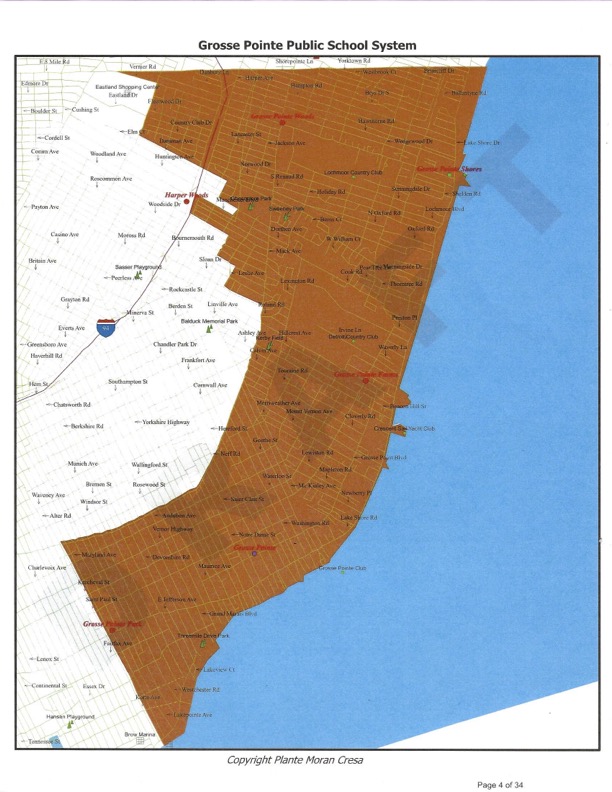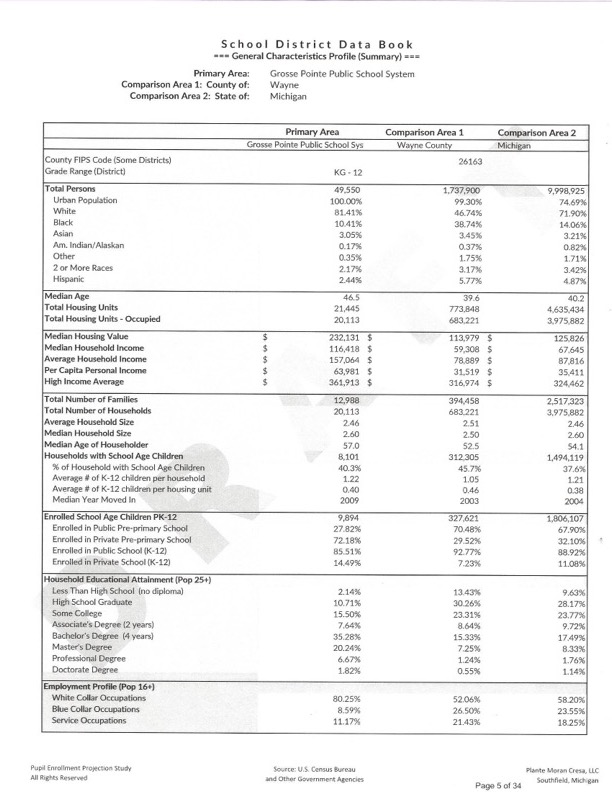In the 2011-12 school year, Grosse Pointe Public Schools had 8,471 students. By the 2021-22 school year, that number fell to 6,651 students. This drop in enrollment has administration concerned.

“People are having fewer children,” said Superintendent Jon Dean. “Thirty or 40 years ago, a family would have five or six children, whereas now they have one or two. Pretty much nobody has big families anymore.”
The Grosse Pointe Public School System has been considered one of the top school districts in the state for years, academically at all levels and athletically at the high school level. But despite all of the success in the district, it has been losing students for years as a result of greater societal issues, and the COVID-19 pandemic didn’t help.
Both high schools in the district compete athletically in MHSAA Class A in almost every sport, with a few exceptions, but Dr. Dan Hartley, director of secondary instruction, said the test scores throughout the district compete with just about anyone in the state. U.S. News ranks both high schools in the district in the top 51 schools in the state.
Grosse Pointe North principal Kate Murray said that Grosse Pointe North offers 22 AP classes, which is an above average level of academic diversity, and that there are programs that the school offers that are completely unique, like applied medical research, which results in Grosse Pointe schools sending more students to medical school at Wayne State University than any other district in the nation. Despite the success of students in the district, administrators worry that due to declining enrollment, they may not be able to have access to such a wide variety of curriculum.
Societal Issues
Grosse Pointe is an older community compared to the surrounding areas, with the median age being 46.5 years old, compared to 39.6 in Wayne County and 40.2 in Michigan. On top of that, the median family size in Wayne County has decreased from 3.25 to 3.17 people
“People are having kids later in life,” said Dean. “which delays students coming in and affects our enrollment.”

Hartley said that people living longer is a good thing, but it makes it harder for new families to move into the community because there are less houses available.
Dean said that the decrease in enrollment is not a problem of more students leaving this district, but less enrolling in kindergarten each year. Each year, GPPSS, with the help of Plante Moran Cresa, completes a Pupil Enrollment Projection Study Report. This report takes data from the US Census Bureau and turns it into future projections of the number of students that will live in the area and be enrolled in Grosse Pointe schools. The most recent report projects up to the year 2026, and uses trends from previous years to predict what the future enrollment numbers will look like.
Between the two high schools, Grosse Pointe North and Grosse Pointe South, 730 students graduated in the class of 2018. In that same year, 447 students were enrolled in kindergarten between the seven elementary schools. While this report can’t perfectly predict the number of students that will be in the district in the future, based on data from previous years, the trend could be cause for concern.
School Board President Joe Herd said that Michigan has been losing more and more people over time, which is the main factor of why enrollment in the district is dropping.
“Enrollment in Grosse Pointe Schools was around 12,000 students at one time, now we’re down to around 6,700,” said Herd. “That’s taken place over about 25 years.”
Dean also said that decreased enrollment is a trend across the state, but added that there are communities with school of choice or that are still building out and expanding, like Romeo, for example, where they are still taking old farms and fields and building new subdivisions.
Hartley said that while Grosse Pointe is not at maximum capacity in terms of population, the community itself will not be growing anytime soon.
“Grosse Pointe is a landlocked community, we’re not building new subdivisions or expanding the community because there’s no space to,” said Hartley. “So we’re not seeing growth that way. But one of the main draws to our schools is the academic programs we have and the success of our students.”
Other school districts in the area have turned to open enrollment and school of choice to help maintain their school populations, but GPPSS has not, and doesn’t plan to in the future.
“It is the only thing that the school board votes 7-0 against every single time,” said Dean. “The taxpayers want their money to go to the kids that live in the community, which is understandable.”
Murray said that to try and fight dropping enrollment the district’s communications team does a great job of highlighting the successes of students in the district.
“They really are out front creating an advertising campaign that highlights all of what students can accomplish in their time in Grosse Pointe,” said Murray.
COVID-19 Pandemic
Along with less children being born and fewer young families moving into the area, the COVID-19 pandemic didn’t help enrollment either.
“We had a group of parents that wanted their kids to have as much in-person learning as possible,” said Dean. “So they pulled their kids out of our schools and put them in private schools that were in-person when we weren’t.”
Herd said that, especially with younger students, some parents were unsure if they wanted to send their kids to school to learn face-to-face during the pandemic were forced to put their kids into private schools because they had difficulties finding child care, but Grosse Pointe schools stayed completely in-person this past school year, and some of those students have begun to come back to the district.
Effects
Dean said that, in 2019, the district voted to close Poupard Elementary school on the north end of the district and Trombly Elementary School on the south end as a result of decreased enrollment, but that no other schools are at risk of closure.
In order to keep students in the schools in Grosse Pointe, top notch education and a wide variety of electives are a top priority of the school district. But, maintaining this variety becomes increasingly difficult as numbers continue to decrease.
“My No.1 concern is figuring out how to still offer comprehensive programs in a wide variety of areas for students with less resources,” said Murray.
Hartley said that the district may be forced to get creative in terms of ensuring that the same number of electives can be offered because less students means the district receives less funding.
“The hallways feel different,” said Murray. “The classrooms don’t feel too different because when the classes get too small we just eliminate sections of the class. For example, if we used to have seven full sections of freshman English, now it would be cut down to five, but the class size is still the same.”
Hartley said that the average class size at the middle school level is about 26-28 students and 28-30 which is the range that the district tries to stay within, but some classes are run above or below these ranges, depending on what the class is.
Murray said that having fewer sections of classes results in teachers being forced to teach additional subjects throughout the day. For example, a teacher who taught U.S. and world history would now have to teach government and economics as well. Having fewer students and teachers that teach more than one subject also creates less of a need for teachers.
“If we have fewer students, over time more staff gets laid off or as they retire they are not replaced,” said Murray.
Murray said her staff understands that enrollment is declining and they know the impacts of the situation, but they still want to figure out ways to offer all of the same programs for students.
Despite all of this, district administration remains positive that this problem will not cause any major issues in the schools.
“In a comparison with like public schools, that being Birmingham and Troy, Grosse Pointe actually has the greatest percentage of eligible children going to the public school system,” said Herd. “So I think we’re going to be OK in the future.”
Hartley said that Grosse Pointe schools will continue to find ways to provide top-notch education for students and provide as much variety for them as possible.
“We feel pretty good about the quality of the education that’s being offered,” said Herd. “Thus far, the curriculum hasn’t been affected, and the teachers that we have are excellent.”